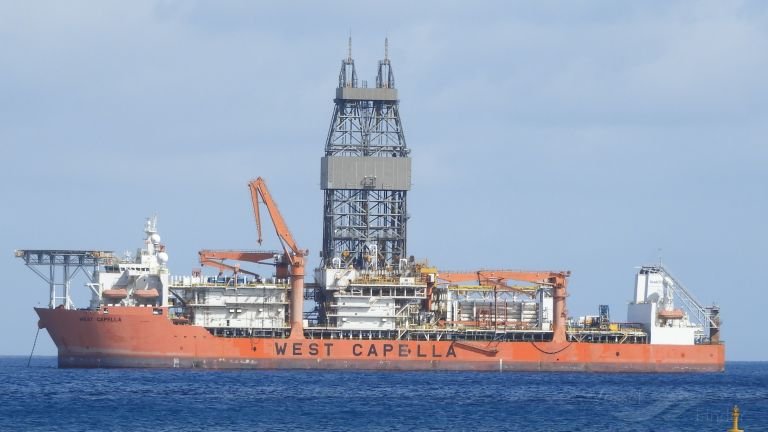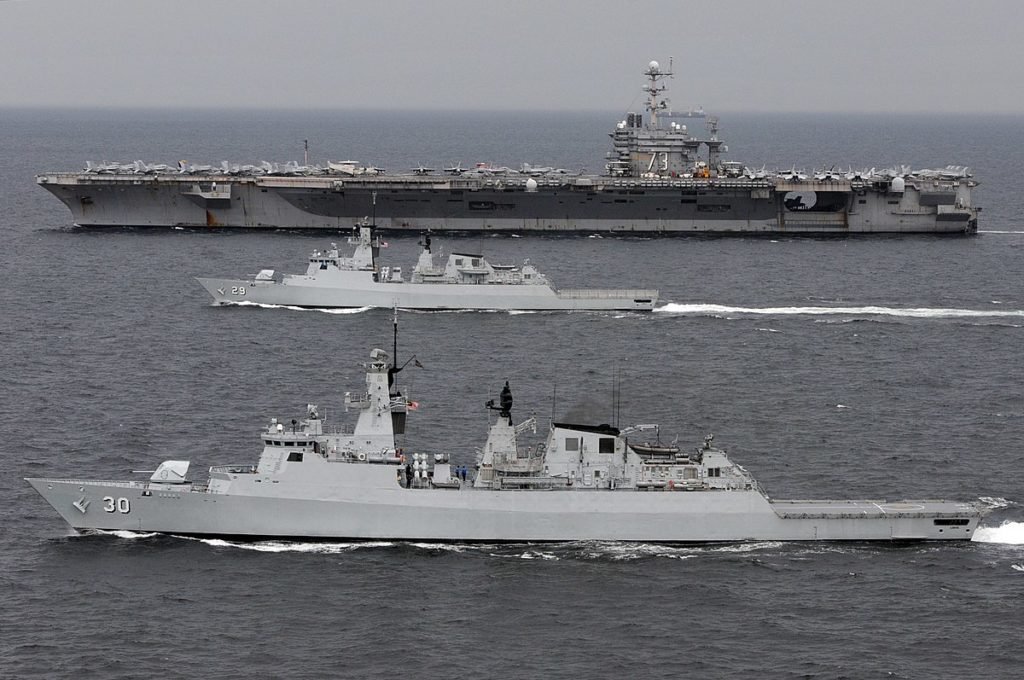
(The potential flashpoint for the next regional war is in the South China Sea where in recent years, the Chinese Government has been very aggressively building naval bases complete with missile launch silos, gun emplacements, radar stations, communications towers, runways for heavy bombers and helipads. Photo source: The Sun UK)

Recently the Chinese Government sent 8 doctors to assist our Ministry of Health on the war to contain and improve the recovery from COVID-19 infections. Health director-general Datuk Dr Noor Hisham Abdullah on April 10 said a team of medical professionals from China would be in Malaysia to lend a helping hand and look at the performance of Malaysia’s hospitals in handling the pandemic.
Related: MH370: Was Air Traffic Control Deliberately Misled?

(West Capella is a 12 years old drilling ship build in 2008, registered in Panama and presently being operated by Petronas. Image source: Vessel Finder)
This gesture of co-operation is indeed much appreciated considering China themselves has just recently recovered from a major pandemic with 4,632 deaths. However, the pandemic did not stop their activities to expand their influence and territory at the global level.
Related: Fire Bomber – MMEA’s Bombardier CL-415
No wonder President Trump still having a phobia of the influence and ambition of the Chinese Government.
Their military had continued their naval manoeuvres in the disputed areas claimed by Malaysia & other countries in the South China Sea. To make things worse, they had even started tagging Malaysian drilling ship to a point it could have caused an accident:-
A Chinese government survey ship was seen tagging an exploration vessel operated by Malaysia’s state oil company Petronas in disputed waters in the South China Sea, three regional security sources have said.
China’s Haiyang Dizhi 8 entered waters near Malaysia last Thursday, according to ship tracking website Marine Traffic.
On Friday, it was close to the Petronas-operated West Capella, according to the security sources, who asked not to be identified.
One of the sources said a Vietnamese vessel was also tagging the West Capella.
A Malaysian security source said the Haiyang Dizhi 8 was flanked at one point on Friday by more than 10 Chinese vessels, including those belonging to maritime militia and the coast guard.
That source also mentioned the Vietnamese vessel.
(Source)

(File photo of Royal Malaysian naval ships – KD Lekiu and KD Jebat in a naval exercise, playing the role of goal-keeper for US nuclear carrier. These vessels represent the best and the deadliest range of deterrence in RMN. The other deadly arsenal is RMN’s Scorpène-class submarines and the Maharaja Lela-class frigates. Image source: Wikipedia)
Related: Full Metal Jacket 1987: Ronald Lee Ermey
And considering this as a threat to Malaysian shipping assets, Royal Malaysian Navy ships are closely monitoring these intruding Chinese vessels with 4 ships (2 from the Royal Malaysian Navy and 2 from the Malaysian Coast Guard). Australian and US naval ships also are monitoring the movement of Chinese naval vessels in the disputed waters:-
An Australian frigate has joined three US warships in the South China Sea near an area where a Chinese vessel is suspected to be exploring for oil, near waters also claimed by Vietnam and Malaysia, officials said on Wednesday (April 22).
The warships arrived this week close to where the Chinese government survey ship Haiyang Dizhi 8 has been operating, which is in turn near where a vessel operated by Malaysia’s Petronas state oil company is conducting exploratory drilling, regional security sources have said.
The US navy said on Tuesday the USS America amphibious assault ship and the USS Bunker Hill, a guided missile cruiser, were operating in the South China Sea.
They were joined by Australia’s frigate HMAS Parramatta and a third US vessel, the destroyer USS Barry, as part of a joint exercise, the Australian defence department said.
(Source)
Related: Movie Review: The Hurt Locker 2010
This blatant action intrusion by the Chinese military into Malaysia’s controlled waters is nothing new. Last year, it was made well known that a Chinese coast guard ship spent almost 300 days in waters claimed by Malaysia.
And there were other well-known intrusions:-
During the first two months of 2017, three Chinese ships patrolled the Luconia Shoals, an area of islets and reefs that are more than 1,000 miles (1,600km) from mainland China and only about 90 miles (145 km) north of Malaysian Borneo.
The ships were traced by the Asia Maritime Transparency Initiative (AMTI), part of Washington’s Center for Strategic and International Studies, and the non-profit Center for Advanced Defense Studies (C4ADS).
The US-based groups said the two months were not unusual and were consistent with regular rotations of up to 11 Chinese patrol ships it had traced in the area since late 2015.
China has installed HQ-9 surface-to-air missiles at one island as well as anti-ship cruise missiles, AMTI said. It had also built enough hangars for 72 combat aircraft and several larger bombers.
(Source)
They have been doing the same with other countries involved in the dispute. The worst incident was early this month when a Vietnamese fishing boat was rammed by a Chinese maritime surveillance vessel near islands in the disputed South China Sea.
In addition to the rampant intrusion by illegal immigrants especially Rohingyas who recently was intercepted by the Malaysian authorities, there is a greater need for Malaysia to increase their patrols in the disputed waters. Perhaps have joint naval & air patrols with other ASEAN countries who also have claims in the disputed areas but also facing the bullying from the Chinese.
The less the presence, the more brazen the Chinese military intrude the disputed areas. They are also getting more arrogant when confronted:-
Navy Chief Abdul Aziz Jaafar said that since late 2014, intrusions by Chinese ships into Malaysian waters have been a daily affair with Kuala Lumpur protesting to Beijing each time. Abdul Aziz told AFP the Chinese vessel involved in the latest incident remained in Malaysian waters.
Abdul Aziz said the Chinese incursion had taken place very close to the Malaysian coast. Abdul Aziz said in the latest incident attempts to communicate with the Chinese vessel to state that it was in Malaysian waters met no response.
“We are on Channel 16. We are communicating through VHF communications. We are telling them this is our waters. (But) they do not respond,” he said.
(Source)

This requires more manpower and newer military assets especially new patrol ships although individually we are no match against the might of the Chinese military powers who now have aircraft carriers and good amphibious capabilities. However frequent military exercises and fire test by the RMN in coordination with other assets from the army & air-force is a must to keep the Chinese military on the edge.
Related: Terrorism 2011: Osama is Dead
In addition to having increased naval patrol and within coordination with other friendly countries like US and Australia, the other way to reduce these intrusions by the Chinese military is by increasing the coordination and bringing the dispute to arbitration by United Nations.
Back in December 2019, Malaysia made new submission of ECS to the United Nations Commission on the Limits of the Continental Shelf. It was after the Vietnam-Malaysia joint submission of an ECS beyond 200 nm in 2009.
Malaysia has killed a couple of birds with one stone.
First, it extends the continental shelf claim illustrated in the Malaysian Department of Mapping and Survey’s 1979 Map in both the southern and northern parts of the SCS to gain almost twice as much as continental shelf compared to the 1979 claim.
Second, it implicitly shows support for the 2016 Tribunal Award that qualified all insular features of the Spratlys archipelago as having only 12 nm territorial sea and no claim to generating their own exclusive economic zones and continental shelves.
Third, the submission indirectly rejects the validity of China’s nine-dash line claim, even though Malaysia was not party to the Philippines’ SCS case.
Fourth, the submissions promotes a similar application of the tribunal’s decision to the Paracels insular features in declaring that the “subject of this Partial Submission is not located in an area which has any land or maritime dispute between Malaysia and any other coastal State.”
Fifth, it prompts other concerned states to talk with Malaysia about delimiting possibly overlapping areas. In this vein, the Philippines may join with Vietnam and Malaysia in submitting tripartite submission on the ECS beyond 200 nm in the future.
Sixth, the submission, done before the end of the Code of Conduct negotiations, allows Malaysia to avoid restrictions in the final COC (if any). It also assists Malaysia in seeking advantages in negotiations related to the SCS.
(Source)
Of course, there is also a small risk of Malaysia buying 4 littoral mission ships from China with the rest of 14 ships to be constructed locally. There were some comments on the internet that this will mean China know the strength and weakness of these ships when it comes to confronting them. However, there is a matter of know the hardware specifications and naval tactics & strategies.
It also matters of using the naval assets in coordination with other naval assets & air assets.